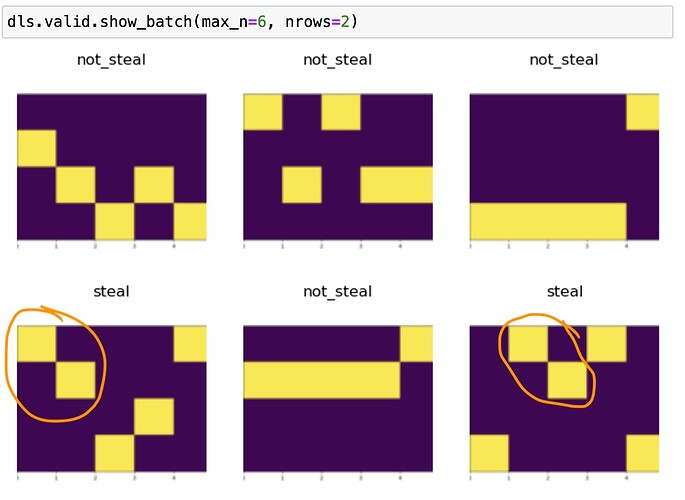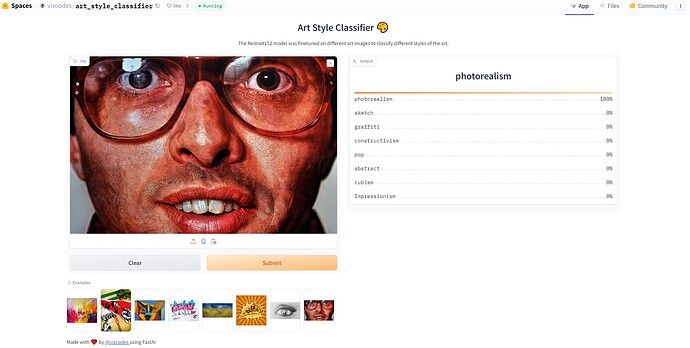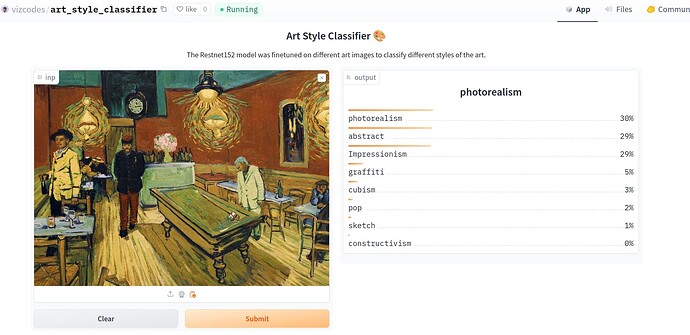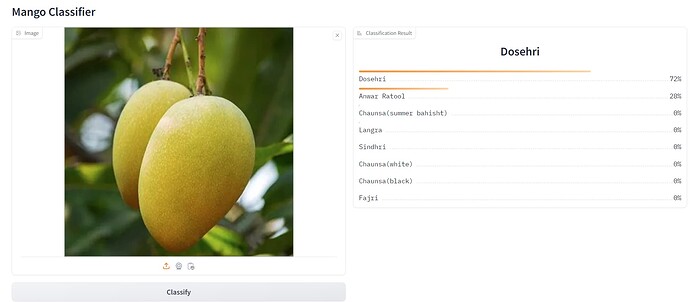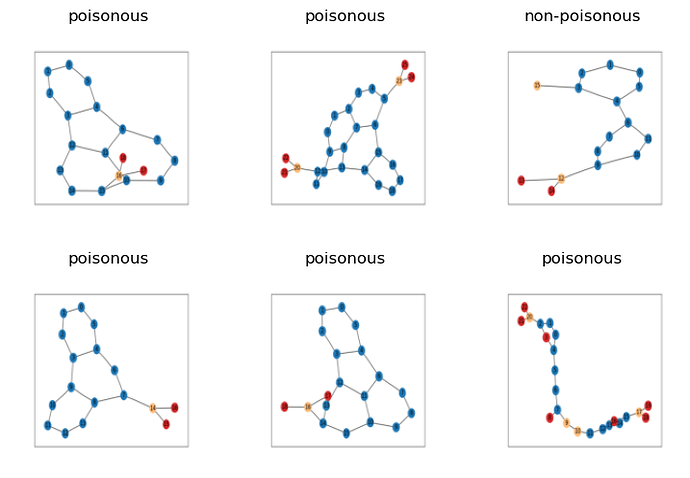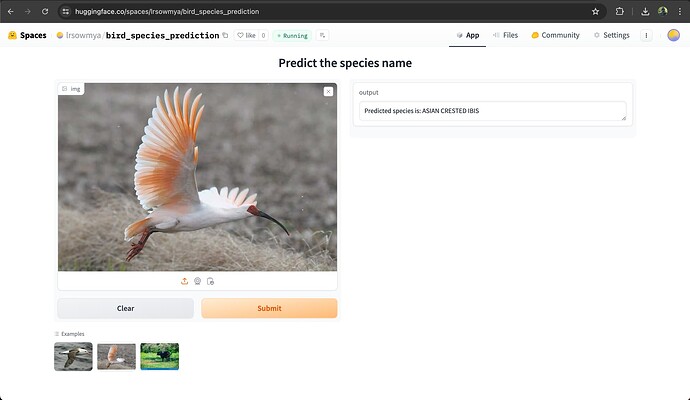I don’t know how baseball works either. But I’m Interested in what the secret is though ![]()
To be a steal, the cell at the second to the top row must be “True” on the right of the top row that is also a “True”.
Tried my own version of classifier by adding one more class instead of two as shown in fast ai lesson 1.
When I was doing this, the football Euro 2024 ![]() was ongoing. Wanted to classify different players; Mbappe, Christiano Ronaldo and Lionel Messi.
was ongoing. Wanted to classify different players; Mbappe, Christiano Ronaldo and Lionel Messi.
Hey peeps!
As part of lesson 02, I fine-tuned a Resnet-152 model to classify art styles based on images; the model is quite good and has an accuracy of 92%.
Please feel free to try it out here and let me know your thoughts: Art Style Classifier - a Hugging Face Space by vizcodes
Looking forward for next lecture!
Great work !! I tried your model . . . with Vincent’s style paintings (Impressionism)
I am thinking - How will you judge/rate your models’s performance.
Like we know the painting is Impressionism, which your model also thinks to be 29%.
Its not photorealism for sure ; which ur model said 30% (idk why it said like that) … And no idea abt abstract - coz literally any painting which i can’t understand seems to be abstract…lol
Also , Looking forward to - How you improve your model…
Coz it might teach us , something abt DL.
Hello guys!!. I’m excited to share my project built after the lesson2 of the course 1 of fastai. It is a Pokemon latest generation(i.e gen9) classifier which classifies the image given to it as to which type it belongs.
I took a week to complete this project because I had a tough time cleaning the images(15000) manually ![]()
I downloaded the images using DuckDuckGo and cleaned it and trained the classifier using resnet34.
After the first lesson, I was amazed to see project built my other peers of this course and so built this. It was an amazing experience building and I hope I will learn a lot by the end of the course.
One problem is that the classifier performs great when images are of good quality and brightness.
Here’s the link of the project Pokemon Gen 9 Classifier
I had the same trouble with finetuning photorealism and good realistic pencil sketches, I think the model is just fine-tuned on over 100 images in each category, probably if we increase the no of images for training and increase the no of epochs, we would get a better model ![]()
But when interpreting art, its all perspective i believe lol!
now it’s DDGS
can always use help(duckduckgo_search) to check the latest name
Barbell deadlift classifier:
I am working on sports and fitness related ideas. Have been a lurker on this forum so I thought I will dive in and build something.
Built a simple classifier based on lesson 1. I used barbell deadlift and a barbell squat images for classification.
I chose this problem because it uses the same implement - the barbell and the positions are not that different. Somewhat closely related I must say. However the model worked surprisingly well after only 3 iterations. I tried with 10 as well. Here’s my notebook.
I want to extend this to videos and other related exercises such as a bench press. DDG has a video search API so that should help. Will try that post lesson 2 or 3.
Hi everyone,
I’ve just finished lesson 2.
Here is what i’ve done so far : vespa classifier
As an amateur beekeeper, I thought about working on a classifier for the european and asian hornets, the latter being a dangerous predator for bees, currently spreading its territory across europe.
I used search_images_ddg for the data, a quick resnet18 to clean the data, and a resnet50 with 10 epochs of fine tuning for the final model. I obtained a good error_rate in the end, around 2 or 3 % if I remember well.
Gradio and HuggingFace make deployment very easy. I could actually tried the app on my phone : took a picture of an hornet, and it gave me the good answer. I was amazed ! A huge thanks to Tanishq for his tutorial, and also to all the forum contributors.
And of course, kudos to Jeremy for all his work towards a more democratic AI. I hope I will be able to finish the course, although I’m yet to find a project to achieve.
For lesson 1, I created a classifier that can tell audi A6 from bmw m3. It works with an error rate of 12% which is decent, I guess. Here it is
I also tried to make a canoe vs kayak vs raft classifier, but couldn’t get the error rate to go below 20%. I wonder why…
After watching the first two videos and browsing the first two chapter I tried implementing the concepts.
I made a “cheetah, leopard, tiger classifier”… the first training with 400 images for each class and 8 epochs, I ended up with 1% error, I faced a challenge where the model would predict “cheetah” correctly with over 90% probability (good confidence), but predicted tiger and leopards correctly with 0% probability.
I tried to change the transform from resize to randomresizecrop, the loss dropped to 0.1% but the performance was still the same.
lastly, i discover that if i use the noun in prural, in the search_function It throws an error during download, I do not know
https://www.kaggle.com/code/emrysnicholaus/notebooka18764c379
Finished lesson 2
In India there are many varieties of mango , I cant classify between them so I made this mango classifier
I found a dataset with only 8 with 200 img each
the image classified in the image is mango image from internet (not in dataset)
got accurate result
here is the model on hugging space if want to try
Hello all!
I have recently started doing Part 1 of the course and I am absolutely enjoying it. As was covered in Lesson 2 of the course, I wanted to build an app which could classify between different Porsche Motorsports car models which have come out over the years. And I did exactly that! I have built a very simple app using Gradio and deployed it on HuggingFace Spaces.
To summarize, the app classifies the following Porsche Motorsports cars: -
-
Porsche 956
-
Porsche 919
-
Porsche 917
-
Porsche 935
-
Porsche 911 RSR Turbo
-
Porsche 804
-
Porsche road car
The Porsche road car class was added to allow the app to distinguish between Porsche’s road cars and their Motorsports cars. This is because some of their motorsports cars are based on their road cars.
The app can be found here.
The complete process of building and deploying the application was quite engaging. Throughout the process, I learned to clean the dataset using the initially trained model itself, learned how to apply data augmentation and improved the dataset by manually adding missing images (for e.g. side and top views for all classes). I ended up training and deploying one of the convnext models as it gave better results than resnet 18 and resent 34.
The model is not perfect though and as the course progresses, I hope the learnings will help in improving the model performance.
I am in the process of writing a blog post about it and I will post a link to it here once it is finished.
Moreover, the complete project will be put up on Github soon!
Thanks!
Hi everyone. For lessons 1 and 2, I’ve created a Western/Sci-fi classifier. I had a lot of fun working on it. The idea is to classify a movie from its poster. I started training with just movie posters but noticed that I actually get more consistent results if I use movie photos in general for training.
Taxonomy Classification with Embedding Quantization and an LLM-based Pipeline
As further research in NLP, I experimented with embedding quantization and LLMs to generate a taxonomy in computational linguistics (arXiv cs.CL), starting from 25k research articles.
Building Blocks:
- Jina-Embeddings-v2, a BERT-ALiBi based attention model.
- Embedding-Quantization using Sentence-Transformers and a custom uint8 quantization implementation.
- Dimensionality Reduction with UMAP.
- HDBSCAN Clustering Analysis using float32 and (u)int8 embedding quantization.
- LLM-based Pipelines with Mistral-7B, Claude 3.5, LangChain, and Pydantic.
*** Molecular Property Prediction with a vision learner ***
Dear FastAI friends,
In the spirit of experimenting and feeling inspired by the applications after lesson 1 I thought I’d share my side project:
I tried applying a vision learner to the task of molecular property prediction. In this domain Graph Neural Networks are king but how well would a vision learner fair with just images of the molecules?
Pretty well it turned out! I experimented with the MUTAG dataset which defines whether molecules are poisonous or not poisonous. The first challenge was getting the graph-structures into images: a few examples can be seen below:
Training a pretrained ResNet on classifying these images I got a pretty impressive test set accuracy of close to 90%. This beat a simple GNN taskes with the same problem by quite a margin.
If you’re interested have a look at the notebook (hope everything works):
https://www.kaggle.com/code/tammodukker/notebookd19415965d
I have interest towards avian research and was wondering how to incorporate AI in it. Thankfully I started to watch fastai videos and did a satisfying work on predicting different species of birds (used datase from kaggle).
Here is the hugging space project did it using radio
Curious to learn more …
Hi guys. Sometimes it can be hard to recognise if the yellow buzzing insect in your garden is a bee or a wasp. To help with this, I wanted to train an image classifier to do just that.
I found a way to download images from iNaturalist (a biodiversity sharing platform) and used fastai to train a ResNet model. I also used Vast.ai to rent a GPU server as I only have a Macbook.
I learned a lot and I’m quite proud of the result. The model is deployed to Huggingface spaces and can be tested out here: huggingface.co/spaces/ranzuh/buzz-buzz-whos-there
To improve it further, I’m considering to have a class for “None of the above”. I could also add more classes and develop an app that allows users to take a picture and classify it on the go.
